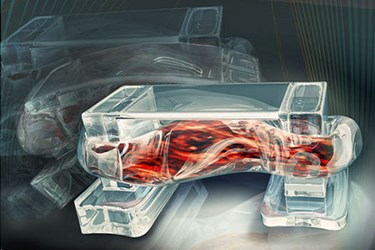New 'Bio-Bots' Move Using Muscle Cells And Electricity
By Joel Lindsey

Researchers at the University of Illinois at Urbana-Champaign have designed “bio-bots” that use a combination of muscle cells and electrical signals to move. The tiny biological machines could prove beneficial in a variety of medical applications, functioning as surgical robots, smart implants, or drug delivery vehicles.
“The idea of doing forward engineering with these cell-based structures is very exciting,” Rashid Bashir, head of bioengineering at the university and lead researcher on the study, said in a press release. “Our goal is for these devices to be used as autonomous sensors. We want it to sense a specific chemical and move towards it, then release agents to neutralize the toxin, for example. Being in control of the actuation is a big step forward toward that goal.”
The new bots, less than one centimeter in size, were designed to mimic the muscle-tendon-bone structure found in many types of animals, including humans.
The researchers began by using a 3D printer to create a hydrogel “backbone,” which was strong enough to give structural support to the robot while also being flexible enough to bend like a joint. Two posts were then used to connect a strip of muscle cells to the backbone. These posts also functioned as feet, allowing the bio-bot to “walk” at various speeds.
“Skeletal muscle cells are very attractive because you can pace them using external signals,” said Bashir. “For example, you would use skeletal muscle when designing a device that you wanted to start functioning when it senses a chemical or when it received a certain signal. To us, it’s part of a design toolbox. We want to have different options that could be used by engineers to design these things.”
According to the press release, the key to this newest bot design is the use of muscle cells, which gave researchers greater control over the device’s movements than in previous designs.
By applying electrical pulses of differing frequencies, researchers were able to remotely turn the devices on and off, as well as control and alter their walking speeds.
“It’s only natural that we would start from a bio-mimetic design principle, such as the native organization of the musculoskeletal system, as a jumping-off point,” said Caroline Cvetkovic, a graduate student involved with the project. “This work represents an important first step in the development and control of biological machines that can be stimulated, trained, or programmed to do work. It’s exciting that this system could eventually evolve into a generation of biological machines that could aid in drug delivery, surgical robotics, ‘smart’ implants, or mobile environmental analyzers, among countless other applications.”
Details regarding the new devices and their performance in early tests have been published recently in Proceedings of the National Academy of Sciences.
Image credit: Janet Sinn-Hanlon, Design Group@VetMed
